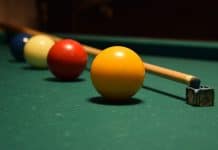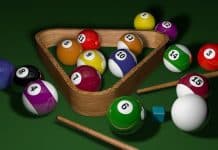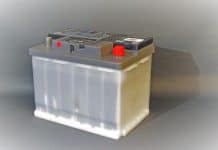In tennis, a “let” means the point stops and players replay it. This happens according to certain rules. A let is most often seen when a serve touches the net but goes into the correct service box. Then, the server gets another try. This rule makes the game fair if the net or players’ readiness cause issues.
In friendly matches, players call lets for their serves. They must talk clearly to avoid arguments. But, in pro tennis, there are umpires and high-tech sensors for this. They help make sure the right calls are made. If a let happens on the first serve, the server tries again. If it happens on the second serve, another serve is given. Remember, if the serve hits the net but goes out of the right box, it’s a fault, not a let.
Some other reasons for a let include noises or actions that mess up a point. This is to keep the game fair and free from distractions.
Key Takeaways
- A let in tennis lets players replay a point under special cases.
- The service let is common, meaning a server gets another try if the ball legally hits the net and lands in the correct box.
- Pro tennis uses technology and umpires to decide service lets, making the game fair.
- A fault is called if a serve hits the net but doesn’t land in the service box.
- In friendly games, players should be clear and on time about let calls to avoid trouble.
- Disruptions can also lead to a let, showing the need for fair and focused competition.
- Knowing and following the let rules helps keep the game running smoothly.
The Basic Principles of a Let in Tennis
In tennis, a let is key to keeping the game fair and moving smoothly. It’s important to know about service lets, the umpire’s job in calling them, and how they’re different from faults and replays. This knowledge is crucial for understanding the rules of the game.
Understanding Service Lets
A service let happens when the ball touches the net on a serve, but still goes into the correct service box. This means the point gets played again. It can also occur if the server serves before the receiver is ready. In casual games, players can call a service let to respect fair play.
The Role of the Umpire and Electronic Sensors
In pro tennis, deciding on a service let isn’t up to the players. The umpire’s role in let calls is backed by special net sensors. These sensors check if the ball touched the net. This tech helps make calls right and keeps the game flowing well.
Replays and Faults: Differentiating the Two
- Replays come into play when a service let is called right. Then, the point is played again without any team losing.
- Faults happen if the serve hits the net and doesn’t go into the right service box. It results in a service loss, not a replay.
It’s vital to tell the difference between a fault and a let under let in tennis rules. This keeps the scoring of the match fair and clear. Knowing this helps keep the game competitive.
What Is a Let in Tennis
The idea of a tennis let is key for understanding the game’s flow and rules. A let definition in tennis covers times when a point is stopped and played again. This is because of certain problems or obstacles. The word ‘let’ comes from an old Saxon term, “lettian,” which means to hinder or make things hard.

In friendly games, players decide if a tennis let is needed. They must do this fast to keep things fair and the game smooth. But in pro tennis, there are set rules and tech to handle lets. This helps reduce arguments and keeps the game going.
A let might be called if the ball hits the net during a serve but still lands in the right spot. This means the serve happens again. Things like a ball from another court rolling in or fans moving too much can also call for a let. This is to keep the game fair and without problems.
- Service lets caused by the ball hitting the net on a serve
- External interruptions like balls from an adjacent court
- Spectator interference or sudden disturbances during a point
Using tennis lets changes between casual and pro games, but the goal is the same. It aims to make sure the game is fair, even when there are issues.
Variations and Exceptions to the Let Rule
In tennis, the let rule is key, and it’s changed over time to be more fair. It’s important for tennis to keep the game moving and fair for all players. The no let rule is interesting, as it’s used in some tennis games to make them quicker and more exciting.
“No Let” Scenarios in Modern Tennis
Recreational tennis often uses the no let rule on serves that touch the net and bounce into the right spot. This rule speeds up the game and adds surprises. It’s different from what many players are used to, which can either make the game more fun or more nerve-wracking.
Alternate Let Calls: Accidental vs. Deliberate Hindrances
Understanding what counts as accidental hindrance vs. deliberate hindrance is crucial for tennis umpires. If something unexpected, like a stray ball, gets in the way, it’s an accidental hindrance and warrants a let call. On the other hand, if someone tries to disturb the other player on purpose, like making a loud noise, they could lose a point.
How Professional Tennis Umpires Handle Lets
Professional tennis umpires combine technology with their sharp eyes and knowledge. They use electronic aids but also rely on their understanding of the game. This way, they make decisions focused on what’s right, both by the rules and for fair play.
| Rule Type | Scenario | Outcome |
|---|---|---|
| No Let Rule | Service hits the net and lands in | Point continues |
| Accidental Hindrance | Stray ball enters court | Point replayed |
| Deliberate Hindrance | Player shouts during opponent’s serve | Point penalty |

Historical and Notable Lets in Tennis
In professional tennis, let calls have created key and memorable moments. These moments show how lets can change the course of a game. For example, in the 2016 Wimbledon quarterfinals, Roger Federer got three service lets in a row. This was rare and changed the game’s flow for a moment.
In the 2013 Miami Open, Serena Williams faced a similar situation. She got four service lets in a row, setting a unique record. These moments underlined the surprise of lets but also highlighted Williams’ ability to stay strong under pressure. They show how lets can affect a match’s speed and the mental game.
These events are not just stories but lessons in adaptability for athletes. Moments like those of Federer and Williams highlight tennis’s unpredictable nature. They show how important it is for players to adjust and stay strong when facing unexpected challenges during important games.
























































